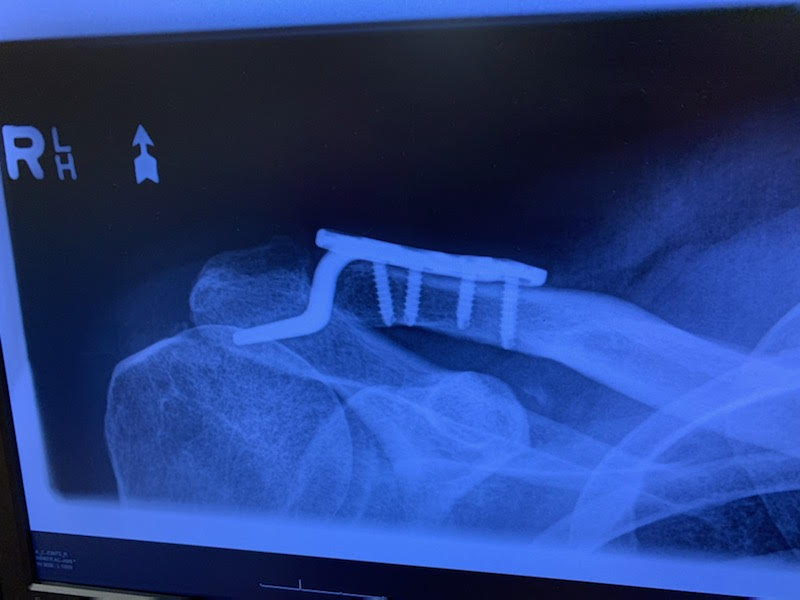Yes, that is what my shoulder looks like from an x-ray. Early June of 2019 I went flying over my handlebars in a cycling race… and that was the end of biking that summer!
Acute pain, surgery (which involved a hook and a plate in my shoulder), pain, rehab, pain, rehab, finally a light at the end of the tunnel, and now staring down a second surgery… which will bring back more pain.
During the 13 years of playing football I had a phone book’s worth of physical injuries. My physio file was THICK! Being young, I always bounced back fast and way too early. As I’ve aged, I’ve noticed the recovery process requires me to be more thoughtful to avoid chronic pain and long-term issues.
What do you do when you are setting up for injury recovery? GO SLOWLY! And be diligent.
Let’s go through the steps of recovering from an injury:
- The acute phase (also known as the “freakin’ painful stage”):
- Assessment: this is where you find out what you did to yourself
- Having a great physio is always a good idea!
- Injuries not requiring a doctor should still be assessed, even if it is a physio
- Sometimes it is painfully obvious that you need to see a Doctor (see above x-ray)
- Having a great physio is always a good idea!
- Very key to get down the swelling
- RICE (we all know it, use it! WebMD breaks it down really simply in this article)
- Rest
- Ice
- Compression
- Elevation
- Pain management:
- Depending on the injury this can range from opioids to simple ibuprofen
- RICE (we all know it, use it! WebMD breaks it down really simply in this article)
- As a trainer and a cyclist my first goal was to MAINTAIN FITNESS!!!:
- Find a way to safely keep up your physical fitness
- Your physiotherapist or doctor can give you ideas
- Find a way to simple cardio!: even indoor, easy pedaling on a bike will keep those muscle tissues firing
- Your certified PERSONAL TRAINER can keep you working the uninjured muscles and with exercise motivation
- if you are wondering if you need a personal trainer read these reasons for training
- Begin the rehab process (also known as the “is this over yet? stage”):
- Guided by your physiotherapist, doctor, or Kinesiologist you should begin to get back movement in your injured joint or muscle
- START SLOW with gentle movement patterns when doing physiotherapy
- DON’T push into pain
- Strength and range of motion will come back, enjoy the process
- Start functional drills at the gym, or in a controlled environment
- Begin using the joint, or muscle, in more functional, sport specific drills
- Get back to doing what you do best:
- Be healed to the point where there is minimal risk of re-injury
- This will be assessed by your physio, coach or fitness expert
- Make sure you do an ADEQUATE WARM-UP
- Get the joint/muscles and surrounding area ready to move
- Have fun, but again, go slowly
These steps will seem to take forever when recovering from acute injuries. BUT, if you are diligent with your physical rehab, listen to your physio, and possibly get some personal training (check us out in Kitsilano, Vancouver), you will be back to chasing your fitness goals in no time!


